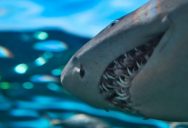Research Shows That The Extinct Megalodon Was One Of The Fastest Sharks To Ever Exist

Add this term to your vocabulary: denticle.
Dermal denticles are V-shaped structures that are more comparable to teeth than scales, found in sharks. They are the reason that a shark’s skin is like velvet – smooth one direction and coarse the other.
Scientists have recently began studying the differing denticles in various species of sharks – past and present – to determine the hunting speeds they were capable of.
Their findings have led to some interesting hypotheses, including the perceived hunting speed of the Otodus megalodon, a species of giant shark that has been extinct for millions of years.
Denticles are thought to decrease drag and turbulence for sharks, meaning they can glide through the water faster and without creating as much noise.
The size and spacing of the denticles possessed by the megalodon is believed to be comparable to the great white shark, Carcharodon carcharias, which enabled scientists to estimate the speed of the megalodon by comparing ridge spacing and the drag reduction efficiency of each species’ denticle structure, as well as the sharks’ body lengths.

The results?
Megalodon was likely hunting at speeds of 5.9 meters (19.4 feet) per second, meanwhile the great white swims at a close second of 5.7 meters (18.7 feet) per second. To put those speeds in context, they’re equivalent to the pace of an average jogger.
And while those speeds are fast, they aren’t the fasted in the ocean; that honor belongs to the shortfin mako shark, Isurus oxyrinchus. By their denticle estimations, they are believed to be clocking hunting speeds of 10.5 meters (34.4 feet) per second.
The study is the first to use X-ray CT to examine the three-dimensional surface morphology of white shark denticles, and could inspire new riblets – a type of structure used to reduce drag in fluid dynamics.
The riblets could be adapted to perform a wide range of tasks at various speeds. It also allows scientists to estimate the swimming speeds of other sharks, including those that are extinct, which could be valuable in future research.

Next time you need a good trivia question, posit which shark is faster: megalodon or the great white.
And you’ll know the answer!
Thought that was fascinating? Here’s another story you might like: Why You’ll Never See A Great White Shark In An Aquarium

Sign up to get our BEST stories of the week straight to your inbox.




